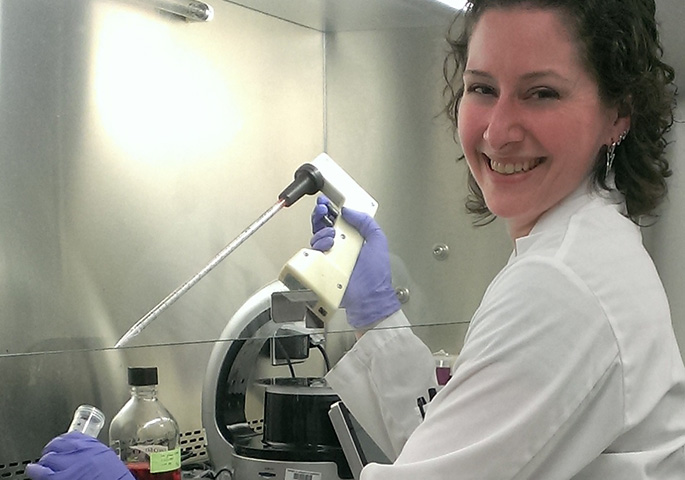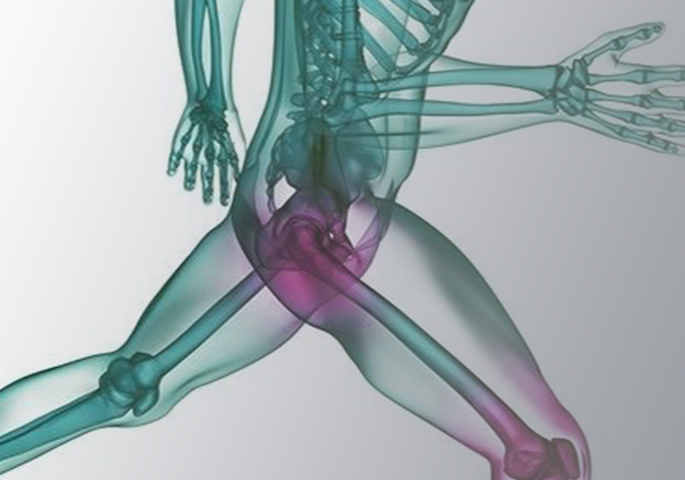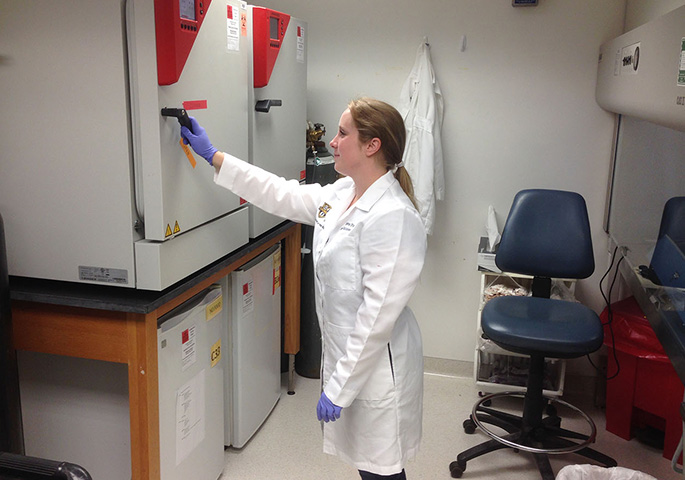Case Study University Rochester
Tasks and objectives:
- Cultivation of stem cells
- Natural physiological conditions
- Precise oxygen control
- Sterile conditions
- Minimal risk of contamination
BINDER solutions:
- CB 160 CO₂ incubator
- Temperature range: ambient temperature plus 7 °C to 50 °C
- Hot-air sterilizable CO₂ sensor
- Auto-sterilization with hot air at 180 °C
- Drift-free CO₂/O₂ sensor technology
- APT.line™ air jacket system
- Seamless, deep-drawn inner chamber without fittings
- Gas mixing head with Venturi effect

The Center for Musculoskeletal Research at the University of Rochester in New York is working on healing bones and fractures using mesenchymal stem cell research.
Life expectancy is on the rise all over the world; in the last 130 years alone, it has more than doubled. This demographic change, plus the fact that the aging population is nevertheless still active and mobile, is leading to an increase in the frequency of musculoskeletal disorders. Whether it is chronic back pain, arthrosis, degenerative joint disease, or fractured hips and broken bones – the question of how to treat such disease and injury presents the field of musculoskeletal research with major challenges. The Center for Musculoskeletal Research at the University of Rochester School of Medicine and Dentistry in New York (URMC) is a specialist in multidisciplinary, comprehensive research into improving musculoskeletal health.
The Center is made up of a highly integrated faculty from a variety of departments, including Orthopaedics and Rehabilitation, Pathology and Laboratory Medicine, Biomedical Engineering, and Medicine (Rheumatology and Endocrinology). This holistic and interlinked concept provides
a wide range of research expertise. From genetic pathways responsible for skeletal development, to skeletal regeneration mechanisms, cell biology methods for restoring cartilage, bone, and connective tissue, through medical problems involving complex fractures and artificial joints: the scientists are trying to solve the mysteries of musculoskeletal health and use their findings in the form of new treatment options for patients. A large part of its research success is based on the Center’s programmatic design. Over 24 faculty members have individual laboratories supporting more than 75 scientists with shared research interests.
Collaborative research efforts have been focused on six different research programs: Bone Biology and Disease, Cartilage Biology and Arthritis, Musculoskeletal Stem Cell Biology, Musculoskeletal Repair and Maintenance, Musculoskeletal Development, and Bone Cancer Biology. Stem cell research has unimagined opportunities to offer in such fields. This is because stem cells play a huge role in the self-healing of injuries and tissue defects. They are able to “migrate” from neighboring tissue into the damaged area and multiply there. The URCM research program for musculoskeletal stem cell biology covers a broad range of applications. It revolves around a thorough investigation of the development and regulation of different types of musculoskeletal stem cells, as well as an exploration of the processes which underlie the ability of the stem cells to multiply, selfrenew, maintain themselves, and differentiate.
This includes mesenchymal stem cells, which create cartilage, bone, fat, and connective tissue, hematopoietic stem cells, i.e., ones that give rise to blood cells, which are found in bone marrow and umbilical cord blood, and skeletal muscle stem cells, which are needed for skeletal muscle growth and regeneration. The stem cells are cultivated in vitro. The Center for Musculoskeletal Research uses BINDER CB series CO₂ incubators for this process. It is important that the cells are able to create their own natural conditions. Whereas the normal oxygen content of the air is around 21%, in the tissue of most types of cell it is much lower, between just 1 and 5%. “Oxygen control of the unit is incredibly important to us, because our cells have to be incubated under their proper physiological conditions in order to get valid results,” explains Brianna Shares, Graduate Student in Eliseev lab. “CO₂ incubators from BINDER keep to the stated values precisely and absolutely reliably,” says Roman Eliseev, MD, PhD, Prinicipal Investigator’. Oxygen control enables hypoxic conditions to be
generated – the oxygen concentration in the incubator interior is reduced and the cells are incubated under their own physiological O₂ partial pressure.
After that, the cultivated cells are analyzed and/or used in further experiments, such as ones involving transfection (the insertion of foreign DNA or
RNA). When it comes to working with these valuable cell cultures, sterile conditions and maximum safety are of the utmost importance. “CO₂ incubators from BINDER feature a highly effective decontamination concept; the risk of potential external contamination is practically non-existent, thanks to automatic sterilization,” concludes Brianna Shares.


Advantages of CO2 incubators:
- Reproducible growth conditions
- High humidity
- Easy to clean
- Stable pH values
- Reliable decontamination concept